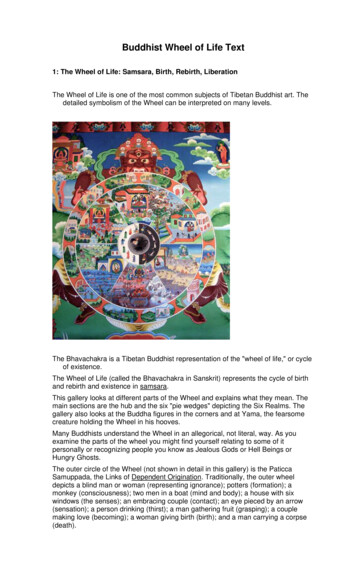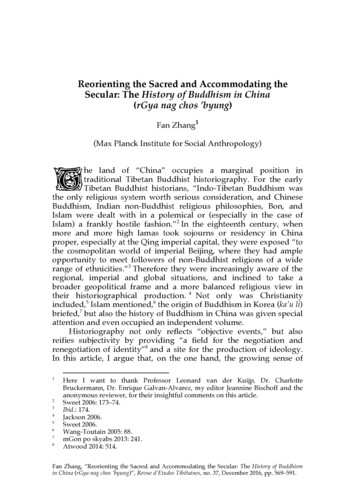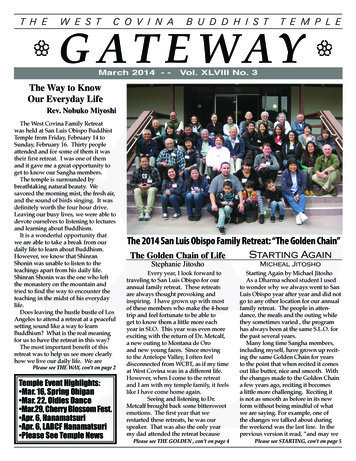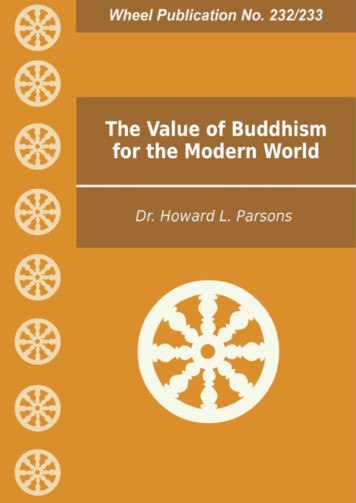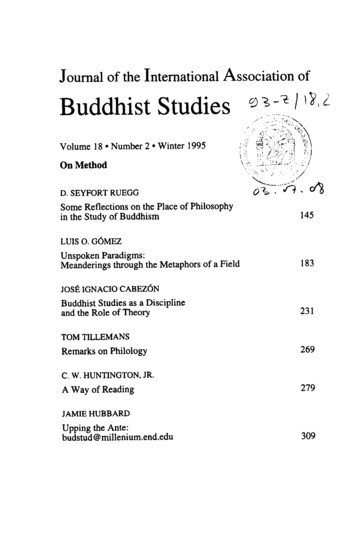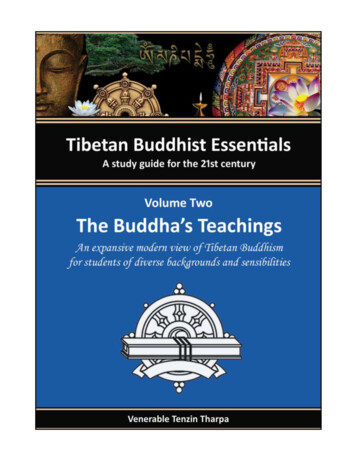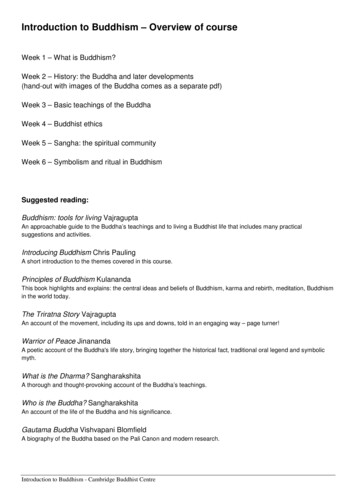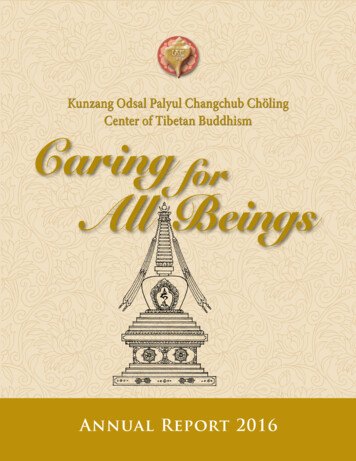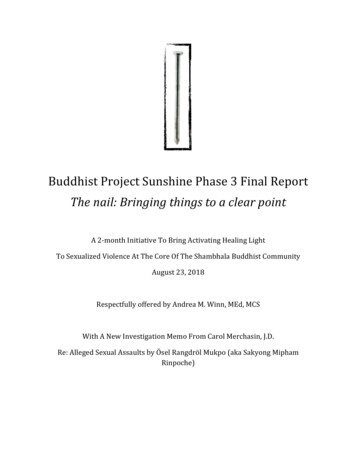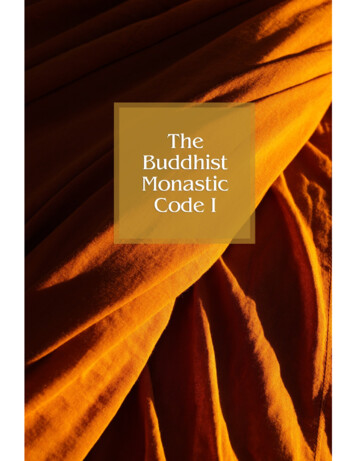
Transcription
TheBuddhistMonasticCode IThe Pāṭimokkha RulesTranslated & Explainedby Ṭhānissaro Bhikkhu(Geoffrey DeGraff)2
third edition, revised: 2013 Ṭhānissaro BhikkhuThis work is licensed under the Creative CommonsAttribution-NonCommercial 3.0 Unported. To see a copy of thislicense visit Commercial” shall mean any sale, whether for commercial ornon-profit purposes or entities.questions about this book may be addressed to:Metta Forest MonasteryValley Center, CA 92082-1409U.S.A.additional resourcesMore Dhamma talks, books and translations by ThanissaroBhikkhu are available to download in digital audio and variousebook formats at dhammatalks.org and accesstoinsight.org.printed copyA paperback copy of this book is available free of charge. Torequest one write to: Book Request, Metta Forest Monastery,PO Box 1409, Valley Center, CA 92082 USA.3
“Now, Ānanda, if it occurs to any of you—‘Theteaching has lost its arbitrator; we are without aTeacher’—do not view it in that way. WhateverDhamma and Vinaya I have pointed out andformulated for you, that will be your Teacherwhen I am gone.”—DN 164
AbbreviationsANAṅguttara NikāyaAsAdhikaraṇa-samathaAyAniyataBDBook of DisciplineBMC1The Buddhist Monastic Code, vol. IBMC2The Buddhist Monastic Code, vol. IICCommentaryCpCariyāpiṭakaCvCullavaggaDNDīgha ��īKhpKhuddakapāṭhaMNMajjhima NikāyaMvMahāvaggaNPNissaggiya kaPvParivāraSNSaṁyutta NikāyaSnSutta NipātaSCSub-commentary5
vinodanīVismVisuddhimaggaNumbers in the references to Mv, Cv, and Pv denotechapter, section and sub-section; in the references to DN,Iti, Khp, and MN, discourse (sutta); in the references to AN,Cp, SN, and Sn, section (saṁyutta or nipāta) anddiscourse; in the references to Dhp, verse.6
PrefaceTHIS VOLUME is the first in a two-volume book that attempts to give anorganized, detailed account of the Vinaya training rules and the traditionsthat have grown up around them. The Pāṭimokkha training rules asexplained in the Sutta Vibhaṅga are the topic of the first volume; the rulesfound in the Khandhakas, the topic of the second. The book as a whole isaimed primarily at those whose lives are affected by the rules—bhikkhuswho live by them, and other people who have dealings with the bhikkhus—so that they will be able to find gathered in one location as much essentialinformation as possible on just what the rules do and do not entail. Studentsof Early Buddhism, Theravādin history, or contemporary Theravādin issuesshould also find this book interesting, as should anyone who is seriousabout the practice of the Dhamma and wants to see how the Buddhaworked out the ramifications of Dhamma practice in daily life.The amount of information offered here is both the book’s strength andits weakness. On the one hand, it encompasses material that in some cases isotherwise unavailable in English or even in romanized Pali, and should besufficient to serve as a life-long companion to any bhikkhu who seriouslywants to benefit from the precise and thorough training the rules have tooffer. On the other hand, the sheer size of the book and the mass of details tobe remembered might prove daunting or discouraging to anyone justembarking on the bhikkhu’s life.To overcome this drawback, I have tried to organize the material in asclear-cut a manner as possible. In particular, in volume one I have analyzedeach rule into its component factors so as to show not only the rule’s preciserange but also how it connects to the general pattern of mindfully analyzingone’s own actions in terms of such factors as intention, perception, object,effort, and result—a system that plays an important role in the training ofthe mind. In volume two, I have gathered rules by subject so as to give aclear sense of how rules scattered randomly in the texts actually relate toone another in a coherent way.Secondly, in volume one I have provided short summaries for thePāṭimokkha rules and have gathered them, organized by topic, in the Rule7
Index at the back of the volume. If you are new to the subject of Buddhistmonastic discipline, I suggest that you read the Rule Index first, to grasp thegist of the main rules and their relationship to the Buddhist path, beforegoing on to the more detailed discussions in the body of the book. Thisshould help you keep the general purpose of the rules in mind, and keep youfrom getting lost in the mass of details.I am indebted to the many people who helped directly and indirectly inthe writing of this book. Phra Ajaan Fuang Jotiko (Phra Khru Ñāṇavisitth)and Phra Ajaan Thawng Candasiri (Phra Ñāṇavisitth), my first teachers inVinaya, gave me a thorough grounding in the subject. Ven. BrahmavaṁsoBhikkhu gave many hours of his time to writing detailed criticisms of earlyversions of the manuscript for the first edition of volume one, forcing me todeepen my knowledge and sharpen my presentation of the topic. As themanuscript of the first edition of that volume approached its final form, Ven.Phra Ñāṇavarodom, Bhikkhu Bodhi, Thiradhammo Bhikkhu, AmaroBhikkhu, Suviro Bhikkhu, Bill Weir, and Doris Weir all read copies of it andoffered valuable suggestions for improvement.In the original conception of this book I planned only one volume,explaining the Pāṭimokkha rules. However, in 1997, Phra Ajaan SuwatSuvaco (Phra Bodhidhammācariya Thera) convinced me that my workwould not be complete until I had added the second volume, on theKhandhaka rules, as well. In the course of researching that volume, I had theopportunity to deepen my knowledge not only of the Khandhakas but alsoof areas in the Sutta Vibhaṅga that I had previously overlooked ormisapprehended. Thus was born the idea for the current revision. My aim incarrying it out has been twofold, both to correct errors and deficiencies inthe first edition and to shape the two volumes into a more coherent whole.This second aim has involved reorganizing the material and adopting a moreconsistent and accurate translation scheme for technical terms. The revisionwas given added impetus from the questions I received from my studentsduring Vinaya classes here at the monastery, and from a series of critiquesand questions I received from bhikkhus in other locations. In addition tocritiques from an anonymous group of bhikkhus in Sri Lanka, I also receivedcritiques from Ven. Jotipālo Bhikkhu, Brahmavaṁso Bhikkhu, BrahmāliBhikkhu, and the late Paññāvuḍḍho Bhikkhu on volume one, and anextended critique from Ven. Bhikkhu Ñāṇatusita on volume two. All of8
these critiques, even in the many areas in which I disagreed with them, havehelped sharpen the focus of the book and made the presentation moreaccurate and complete. I am grateful for the time that my fellow bhikkhushave devoted to making this work more useful and reliable. Many lay peoplehave provided help as well, in particular Thomas Patton, who providedreferences to the Burmese edition of the Canon, and Olivia Vaz and V.A.Ospovat, who helped with the proofreading. I, of course, remain responsiblefor any errors it may still contain.For anyone familiar with the first edition of this book, the most obviouschange will be the book’s increased size. This is the result of a felt need tomake its coverage more comprehensive. In the first instance, this has meantproviding a more detailed account of the material in the Canon andcommentaries. This in turn has uncovered more points where thecommentaries conflict with the Canon, all of which required determiningwhat seemed to be the most correct interpretation of the points in question. Ihave also found it necessary to take into account the variant readings foundin the four major editions of the Canon: Thai, Sri Lankan, Burmese, andEuropean PTS. In the first edition of this book I limited my attention to theThai edition, but I have since come to realize the need to sift through all foureditions to find the best readings for the rules and their explanatory material.This point I discuss in detail in the Introduction to volume one. What itmeans in practice is that when the variant readings touch on importantissues and would clearly make a practical difference, I have had to devote afair amount of space to explaining my preference for one over the others. Atfirst I wanted to avoid dealing with these issues in the body of the book, butgiven the still unsettled nature of our current knowledge of the Canon, Ifound them unavoidable. I hope that these discussions will not interferewith understanding the general thrust of each rule. Again, if you are new tothe subject of Buddhist monastic discipline, you can skip over thesescholarly discussions during your first read-through. Then, when yourknowledge of the Vinaya is more solid and you feel so inclined, you canreturn to them at a later time.Although my general policy has been to accept the most coherentreading regardless of which edition it appears in, I have had to depart fromthis policy in one area, that of the transaction statements used inCommunity meetings. Each edition has its own standards for determining9
word order and orthography for these statements, and in almost all casesthese variant standards make no practical difference. Thus, instead of tryingto establish a preferred reading in every case, I have—for consistency’s sake—followed the Thai standard throughout, and have noted variants onlywhere they seem important.One last practical note: Even though I have consulted all four majoreditions of the Canon, I have provided reference numbers only to one—thePTS edition—as that is the edition most readily available to my readers.References to the commentaries have been handled as follows: When, in thecourse of discussing rule x, I cite the Commentary to rule x, I simply say,“The Commentary says .” When I augment the discussion of rule x with acitation from the Commentary to rule y, I say, “The Commentary to rule ysays .” These references may then be easily found in the area of theCommentary devoted to the relevant rule, x or y, regardless of the editionconsulted.When the first editions of volumes one and two were printed, the primarydedicatees were still alive. Both, however, have since passed away, but myrespect and gratitude to them have not diminished. So I now dedicate thevolumes to their memory. In the case of this first volume, that dedication isto the memory of my preceptor, Phra Debmoli (Samrong Guṇavuḍḍho) ofWat Asokaram, Samut Prakaan, Thailand, as well as to all my other teachersin the path of the Dhamma-Vinaya.Ṭhānissaro Bhikkhu(Geoffrey DeGraff)Metta Forest MonasteryValley Center, CA 92082-1409 U.S.A.May, 2007This third revised edition was inspired by questions from many of myfellow bhikkhus, in particular Vens. Nyanadhammo, Jotipālo, Khematto, andKusalī.November, 201310
IN TRODUCTIONDhamma-VinayaDhamma-Vinaya was the Buddha’s own name for the religion hefounded. Dhamma—the truth—is what he discovered and pointed out asadvice for all who want to gain release from suffering. Vinaya—discipline—is what he formulated as rules, ideals, and standards of behavior for those ofhis followers who go forth from home life to take up the quest for release ingreater earnestness. Although this book deals primarily with discipline, weshould note at the outset that total training in the Buddha’s path requiresthat Dhamma and Vinaya function together. In theory they may be separate,but in the person who practices them they merge as qualities developed inthe mind and character.“Gotamī, the qualities of which you may know, ‘These qualities lead todispassion, not to passion; to being unfettered and not to beingfettered; to shedding and not to accumulating; to modesty and not toself-aggrandizement; to contentment and not to discontent; toseclusion and not to entanglement; to aroused energy and not tolaziness; to being unburdensome and not to being burdensome’: Youmay definitely hold, ‘This is the Dhamma, this is the Vinaya, this is theTeacher’s instruction.’”—Cv.X.5Ultimately, the Buddha said, just as the sea has a single taste, that of salt,so too the Dhamma and Vinaya have a single taste: that of release. Theconnection between discipline and release is spelled out in a passage thatrecurs at several points in the Canon:“Discipline is for the sake of restraint, restraint for the sake of freedomfrom remorse, freedom from remorse for the sake of joy, joy for thesake of rapture, rapture for the sake of tranquility, tranquility for thesake of pleasure, pleasure for the sake of concentration, concentrationfor the sake of knowledge and vision of things as they have come tobe, knowledge and vision of things as they have come to be for thesake of disenchantment, disenchantment for the sake of dispassion,11
dispassion for the sake of release, release for the sake of knowledgeand vision of release, knowledge and vision of release for the sake oftotal unbinding through non-clinging.”—Pv.XII.2In establishing his religion of release, though, the Buddha did not simplyset out a body of recommendations and rules. He also founded a company(parisā) of followers. This company falls into four main groups: bhikkhus(monks), bhikkhunīs (nuns), lay men, and lay women. Although the Buddhasaw no need to organize the laity in any manner, he arranged for thebhikkhus and bhikkhunīs—who had given up the entanglements of thehousehold life to devote themselves more fully to the goal of release—todevelop into communities. And he saw that they needed, as all communitiesdo, ideals and standards, rules and customs to ensure their stability. Thisneed is what gave rise to the Vinaya.In the early years of the Buddha’s career, the texts tell us, there was noneed to formulate monastic disciplinary rules. All of the bhikkhus in hisfollowing—the Community of bhikkhunīs had not yet been started—weremen of high personal attainments who had succeeded in subduing many orall of their mental defilements. They knew his teachings well and behavedaccordingly. The Canon tells of how Ven. Sāriputta, one of the Buddha’sforemost disciples, asked the Buddha at an early date to formulate aPāṭimokkha, or code of rules, to ensure that the celibate life the Buddha hadfounded would last long, just as a thread holding together a floralarrangement ensures that the flowers are not scattered by the wind. TheBuddha replied that the time for such a code had not yet come, for even themost backward of the men in the Community at that time had already hadtheir first glimpse of the goal. Only when mental effluents (āsava) madethemselves felt in the Community would there be a need for a Pāṭimokkha.As time passed, the conditions that provided an opening for the effluentswithin the Community eventually began to appear. The Bhaddāli Sutta( MN 65) presents the Buddha at a later point in his career listing theseconditions as five:Ven. Bhaddāli: “Why is it, venerable sir, that there used to be fewertraining rules and more bhikkhus established in the knowledge ofAwakening? And why is it that there are now more training rules andfewer bhikkhus established in the knowledge of Awakening?”12
[Bhaddāli, who has been unwilling to abide by the training rules,seems to be suggesting that the rise in the number of training rules isitself the cause for fewer bhikkhus’ attaining Awakening. The Buddha,however, offers a different explanation.]The Buddha: “So it is, Bhaddāli. When beings have begun todegenerate and the true Dhamma has begun to disappear, there aremore training rules and fewer bhikkhus established in the knowledgeof Awakening. The Teacher does not lay down a training rule for hisdisciples as long as there are no cases where the conditions that offer afoothold for the effluents have arisen in the Community. But whenthere are cases where the conditions that offer a foothold for theeffluents have arisen in the Community, then the Teacher lays down atraining rule for his disciples so as to counteract those very conditions.“There are no cases where the conditions that offer a foothold forthe effluents have arisen in the Community as long as the Communityhas not become large. But when the Community has become large,then there are cases where the conditions that offer a foothold for theeffluents arise in the Community, and the Teacher then lays down atraining rule for his disciples so as to counteract those veryconditions. When the Community possesses great material gains.great status. a large body of learning . When the Community islong-standing, then there are cases where the conditions that offer afoothold for the effluents arise in the Community, and the Teacherthen lays down a training rule for his disciples so as to counteractthose very conditions.”Thus the rules themselves were not the cause for degeneracy in theCommunity, and the conditions that provided a foothold for the effluentswere not themselves effluents. Rather, the growing complexity of theCommunity provided the opportunity for bhikkhus to act on the basis oftheir defilements in a growing variety of ways, and the rules—althoughthey could not prevent any of the five conditions—had to becomecorrespondingly complex to counteract the opportunities those conditionsprovided for unenlightened behavior.Even when these conditions did arise, though, the Buddha did not set outa full code at once. Instead, he formulated rules one at a time in response to13
events. The considerations that went into formulating each rule are bestillustrated by the events surrounding the formulation of the first.Ven. Sudinna, the story goes, had strong faith in the Buddha and hadordained after receiving his parents’ grudging consent. He was their onlychild and, though married, was childless. His parents, fearing that thegovernment would confiscate their property at their death if it had no heir,devised various schemes to lure Ven. Sudinna back to the lay life, but to noavail. Finally, his mother realized that he was firm in his intention to stay abhikkhu and so asked him at least to have intercourse with his former wifeso that their property would have an heir. Ven. Sudinna consented, took hiswife into the forest, and had intercourse three times.Immediately he felt remorse and eventually confessed his deed to hisfellow bhikkhus. Word reached the Buddha, who called a meeting of theCommunity, questioned Ven. Sudinna, and gave him a rebuke. The rebukefell into two major parts. In the first part, the Buddha reminded Ven.Sudinna of his position as a samaṇa—a monk or contemplative—and thathis behavior was unworthy of his position. Also, the Buddha pointed out tohim the aims of the teaching and noted that his behavior ran counter tothem. The implication here was that Ven. Sudinna had not only actedinconsistently with the content of the teaching, but had also shown callousdisregard for the Buddha’s compassionate aims in making the Dhammaknown.“‘Worthless man, it is unseemly, out of line, unsuitable, and unworthyof a contemplative; improper and not to be done . Haven’t I taughtthe Dhamma in many ways for the sake of dispassion and not forpassion; for unfettering and not for fettering; for freedom fromclinging and not for clinging? Yet here, while I have taught theDhamma for dispassion, you set your heart on passion; while I havetaught the Dhamma for unfettering, you set your heart on beingfettered; while I have taught the Dhamma for freedom from clinging,you set your heart on clinging.“‘Worthless man, haven’t I taught the Dhamma in many ways forthe fading of passion, the sobering of intoxication, the subduing ofthirst, the destruction of attachment, the severing of the round, theending of craving, dispassion, cessation, unbinding? Haven’t I in many14
ways advocated abandoning sensual pleasures, comprehendingsensual perceptions, subduing sensual thirst, destroying sensualthoughts, calming sensual fevers? Worthless man, it would be betterthat your penis be stuck into the mouth of a poisonous snake thaninto a woman’s vagina. It would be better that your penis be stuck intothe mouth of a black viper than into a woman’s vagina. It would bebetter that your penis be stuck into a pit of burning embers, blazingand glowing, than into a woman’s vagina. Why is that? For that reasonyou would undergo death or death-like suffering, but you would noton that account, at the break-up of the body, after death, fall into aplane of deprivation, a bad destination, a lower realm, hell. But for thisreason you would, at the break-up of the body, after death, fall into aplane of deprivation, a bad destination, a lower realm, hell .“‘Worthless man, this neither inspires faith in the faithless norincreases the faithful. Rather, it inspires lack of faith in the faithlessand wavering in some of the faithful.’”The second part of the rebuke dealt in terms of personal qualities: thosethat a bhikkhu practicing discipline is to abandon, and those he is todevelop.“Then the Blessed One, having in many ways rebuked Ven. Sudinna,having spoken in dispraise of being burdensome, demanding, arrogant,discontented, entangled, and indolent; in various ways having spokenin praise of being unburdensome, undemanding, modest, content,scrupulous, austere, gracious, self-effacing, and energetic; havinggiven a Dhamma talk on what is seemly and becoming for bhikkhus,addressed the bhikkhus.”This was where the Buddha formulated the training rule, after firststating his reasons for doing so.“‘In that case, bhikkhus, I will formulate a training rule for thebhikkhus with ten aims in mind: the excellence of the Community, thecomfort of the Community, the curbing of the impudent, the comfortof well-behaved bhikkhus, the restraint of effluents related to thepresent life, the prevention of effluents related to the next life, thearousing of faith in the faithless, the increase of the faithful, the15
establishment of the true Dhamma, and the fostering of discipline.’”These reasons fall into three main types. The first two are external: 1) toensure peace and well being within the Community itself, and 2) to fosterand protect faith among the laity, on whom the bhikkhus depend for theirsupport. (The origin stories of the various rules depict the laity as being veryquick to generalize. One bhikkhu misbehaves, and they complain, “How canthese Sakyan-son monks do that?”) The third type of reason, though, isinternal: The rule is to help restrain and prevent mental effluents within theindividual bhikkhus. Thus the rules aim not only at the external well beingof the Community but also at the internal well being of the individual. Thislatter point soon becomes apparent to anyone who seriously tries to keep tothe rules, for they foster mindfulness and circumspection in one’s actions,qualities that carry over into the training of the mind.Over the course of time the Buddha formulated more than 200 major andminor rules, forming the Pāṭimokkha that was recited fortnightly in eachCommunity of bhikkhus. In addition, he formulated many other minor rulesthat were memorized by those of his followers who specialized in the subjectof discipline, but nothing is known for sure of what format they used toorganize this body of knowledge during his lifetime.After his total nibbāna, though, his followers made a concerted effort toestablish a standard canon of Dhamma and Vinaya, and the Pali Canon aswe know it began to take shape. The Vinaya was organized into two mainparts: 1) the Sutta Vibhaṅga, the ‘Exposition of the Text’ (which from hereon we will refer to simply as the Vibhaṅga), containing almost all thematerial dealing with the Pāṭimokkha rules; and 2) the Khandhakas, orGroupings, which contain the remaining material organized looselyaccording to subject matter. The Khandhakas themselves are divided intotwo parts, the Mahāvagga, or Greater Chapter, and the Cullavagga, or LesserChapter. Historians estimate that the Vibhaṅga and Khandhakas reachedtheir present form in approximately the 2nd century B.C.E., and that theParivāra, or Addenda—a summary and study guide—was added a fewcenturies later, closing the Vinaya Piṭaka, the part of the Canon dealing withdiscipline.Because the purpose of this volume is to translate and explain thePāṭimokkha, we are most directly concerned with the Vibhaṅga. It is16
organized as follows: The rules in the Pāṭimokkha are presented one by one,each rule preceded by an origin story relating the events leading up to itsformulation. In some instances a rule went through one or morereformulations, in which case an additional story is provided for eachamendment to show what prompted it. With each new formulation of a rule,any previous formulations were automatically rescinded. Otherwise, theadded restrictions or allowances contained in the reformulations would havebeen rendered meaningless. Thus, the final formulation of the rule is theauthoritative one, with the earlier formulations holding only historicalinterest.After the final statement of the rule is a word-analysis (pada-bhājaniya),which explains in detail most of the important terms in the rule. For many ofthe rules this analysis includes one or more “wheels,” or tables, giving thecontingencies connected with the rule, working out all their possiblepermutations and passing judgment as to what penalty, if any, eachpermutation entails. For example, the discussion of the first rule contains awheel that gives all the objects with which a person might have sexualintercourse, lists them against the variables of the sort of intercourse andwhether or not the bhikkhu involved gives his consent, and announces thepenalty for each possible combination of factors.Following the word-analysis for each rule is a section of non-offenseclauses, listing extenuating circumstances under which a bhikkhu would beexempted from the penalty imposed by the rule.Finally, for the major rules, there is the Vinita-vatthu, or Precedents,listing various cases related to the rule and giving verdicts as to whatpenalty, if any, they entail.The Vibhaṅga forms the basis for most of the explanations of the trainingrules given in this volume. However, there are many questions on which theVibhaṅga is silent or unclear. To answer these questions, I have turnedeither to the Khandhakas or to the commentarial literature that has grownup around the Vinaya over the course of the centuries. The primary works Ihave consulted are these:1) The Samanta-pāsādikā—“The Thoroughly Inspiring”—(from here onreferred to as the Commentary), a commentary on the Vinaya Piṭakacompiled in the 5th century C.E. by Bhadantācariya Buddhaghosa, who17
based his work on ancient commentaries. The originals for these ancientcommentaries may have been brought to Sri Lanka from India andtranslated into Sinhalese, but frequent references throughout thecommentaries to places and people in Sri Lanka show that much of thematerial in the commentaries was composed in Sri Lanka. From internalevidence in Buddhaghosa’s writings—he compiled commentaries on amajor portion of the Canon—historians have estimated that the ancientcommentaries were collected over a span of several centuries and closed inapproximately the 4th century C.E. Buddhaghosa’s work thus containsmaterial much older than his date would indicate.By Buddhaghosa’s time a belief had grown up that the ancientcommentaries were the work of the Buddha’s immediate disciples and thusindisputably conveyed the true intent of the Canon. However, as we shallsee below, the ancient commentaries themselves did not make such exaltedclaims for themselves.Still, the existence of this belief in the 5th century placed certainconstraints on Buddhaghosa’s work. At points where the ancientcommentaries conflicted with the Canon, he had to write the discrepanciesoff as copier’s mistakes or else side with the commentaries against theCanon. At a few points, such as his explanation of Pc 9, he providesarguments effectively demolishing the ancient commentaries’ interpretationbut then backs off, saying that the ancient commentaries must be rightbecause their authors knew the Buddha’s intentions. Perhaps pressure fromthe elder bhikkhus at the Mahāvihāra in Anurādhapura—the place wherethe ancient commentaries had been preserved and where Buddhaghosa wasallowed to do his work—was what made him back off in this way. At anyrate, only on points where the different ancient commentaries were silent orgave divergent opinions did he feel free to express his own.2) The Kaṅkhā-vitaraṇī—“The Subjugator of Uncertainty”—(theK/Commentary), a commentary on the Pāṭimokkha also compiled byBuddhaghosa. Although this work is largely a synopsis of material in theCommentary, it contains some independent material, in particular a systemof classifying the offenses under each training rule into their componentfactors. It also contradicts the Commentary from time to time, suggestingthat it may have been based on a commentarial tradition different from theone underlying the Commentary.18
3) The Sārattha-dīpanī—“The Essence-Meaning Illustrator”—(the Subcommentary), a sub-commentary on the Commentary, written in Sri Lankain the 12th century C.E. by a Ven. Sāriputta, the first Mahāsāmin, or head ofthe Sri Lankan Saṅgha, after that Saṅgha was reformed and unified underthe patronage of King Parakrāmabāhu I. This work not only explains theCommentary but also deals with points in the Canon itself, sometimesindicating passages where the Commentary has deviated from the Canon. Italso quotes as authoritative the judgments of three ancient texts—theGaṇṭhipadas, which are no longer extant—and of Ven. Buddhadatta, ascholar of the 4th century C.E. who wrote two extant Vinaya guides.4) The Vimati-vinodanī—“The Remover of Perplexity”—(the V/Subcommentary), another 12th-century sub-commentary, written in southernIndia by a Ven. Kassapa, who also wrote the Mohavicchedanī, a synopsis ofthe Abhidha
More Dhamma talks, books and translations by Thanissaro Bhikkhu are available to download in digital audio and various ebook formats at dhammatalks.org and accesstoinsight.org. printed copy A paperback copy of this book is available free of charge. To request one write to: Book Request, M

